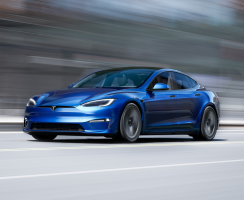
— A Tesla Autopilot lawsuit alleges a 2017 Model S crash occurred even though the driver "was actively and consciously maintaining active supervision of the vehicle, including keeping his hands on the steering wheel."
Plaintiff Christopher Hinze was driving the Model S in June 2020 while traveling on Interstate 66 in Virginia while the owner of the car was in the passenger seat.
Hinze says he activated Autopilot on the open highway and the Model S navigated the interchange from I-66 to I-495 and began traveling northbound on I-495.
The lawsuit alleges the car "maintained its reasonable rate of speed and Plaintiff was actively and consciously maintaining active supervision of the vehicle, including keeping his hands on the steering wheel, which is required in order to keep the Autopilot engaged."
The vehicle reached an area of the freeway near the northbound ramp to enter Route 123 and the Model S correctly moved into the exit lane and began to accelerate, which the plaintiff assumed was the routine Autopilot response to the road conditions.
"Route 123 interchange features a significant curve to the east that must be navigated in order to safely complete the interchange. Based on Tesla's representations regarding the Autopilot feature and its performance during the journey so far, Plaintiff reasonably expected that the vehicle would be able to successfully navigate the transition road between the two freeways and proceed with the trip." — Tesla Autopilot lawsuit
However, the plaintiff says he quickly realized Autopilot wasn't going to reduce the speed, at which time the Model S allegedly traveled forward against the curve where the car left the road.
According to the Model S lawsuit, Hinze has no memory of the impact, but the lawsuit alleges the car "almost immediately came to a halt in a head-on collision at speed into a tree in the waste area between the highway and the interchange."
Hinze says he was "rendered unconscious for a brief period; suffered a catastrophic and unstable shattering of his L4 spinal vertebra; a fracture of his L1 vertebra; and chest injuries. Plaintiff was rushed by EMS personnel into emergency surgery for approximately eight hours at the Inova Fairfax hospital in northern Virginia."
The plaintiff also alleges he had to undergo surgeries and spinal fusions using screws and supporting plates along his lower spine, while his other injuries "had to heal of their own accord."
Mr. Hinze says he spent weeks in rehab and continues to suffer pain, weakness and numbness in both lower legs.
Tesla allegedly collects crash data but then refuses to give the information to the owner. Instead, Tesla allegedly provides just a summary of the crash data even though the owner paid tens of thousands of dollars for the car which generates the data.
According to the lawsuit, Mr. Hinze was seriously injured due to the consequences of computer "bugs" and "glitches" which allegedly caused the Model S crash.
The Tesla Autopilot crash lawsuit was filed in the Alameda County California Superior Court: Christopher Hinze v. Tesla, Inc, et al.
The plaintiff is represented by McCune Wright Arevalo, LLP.




